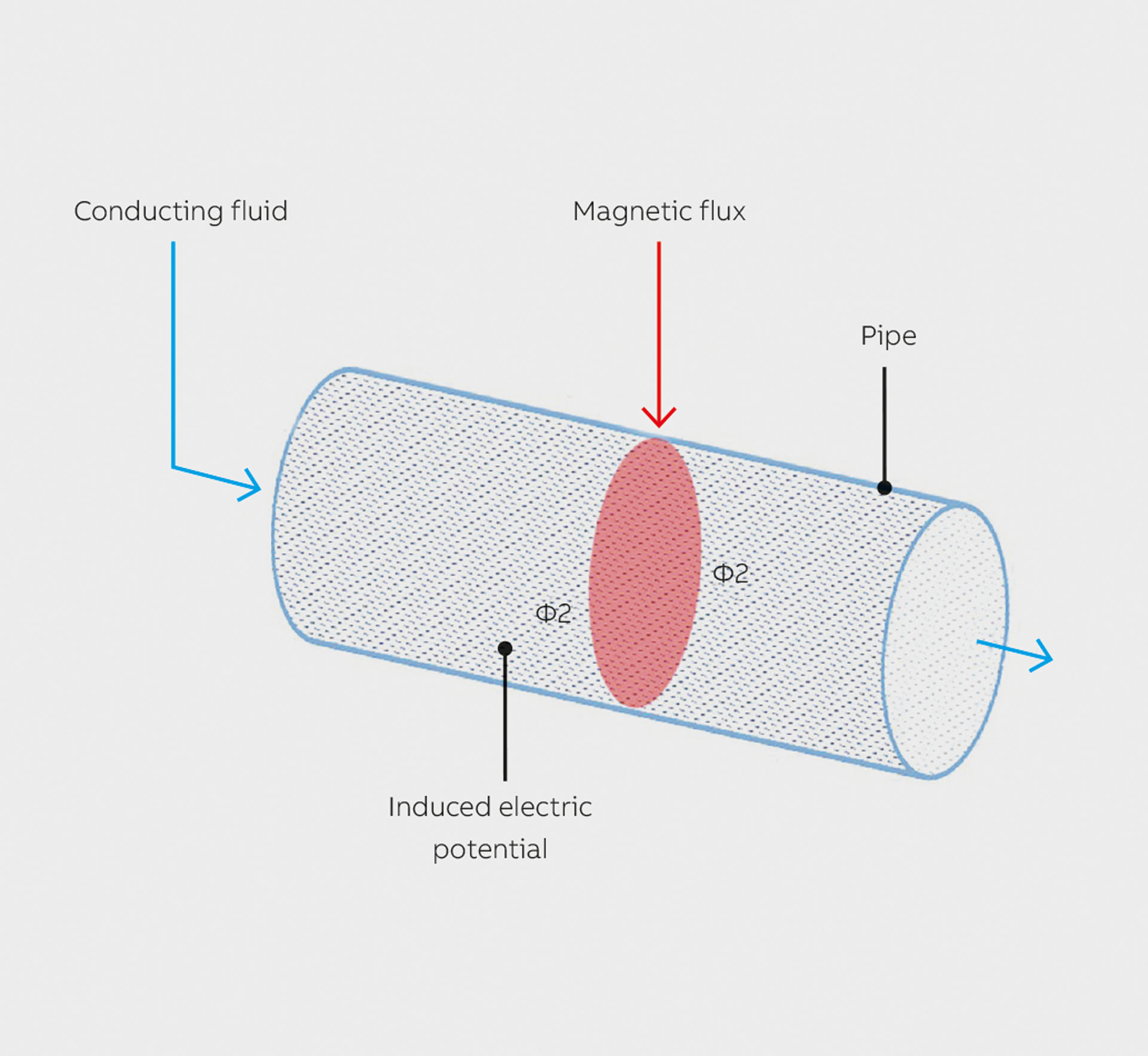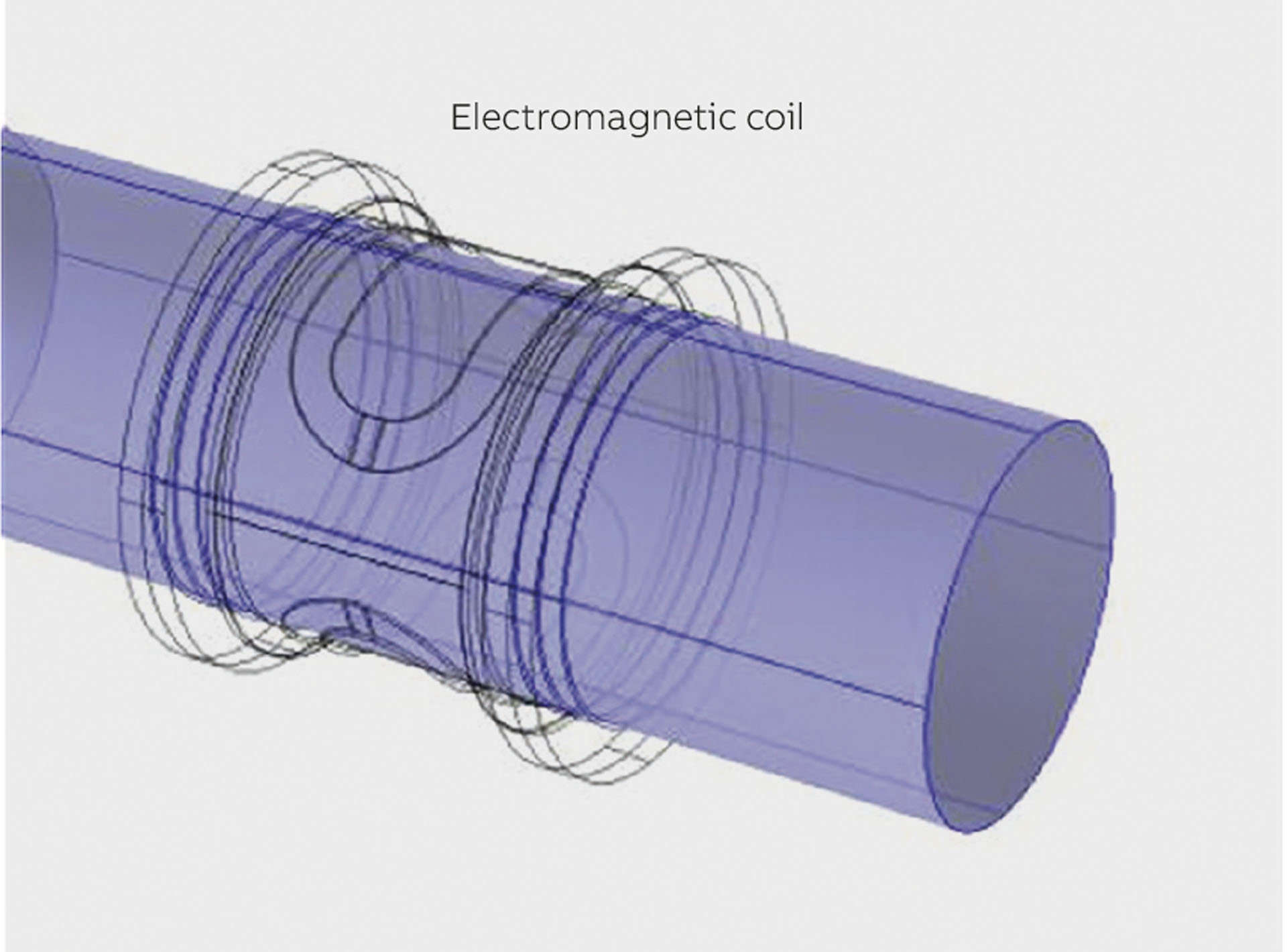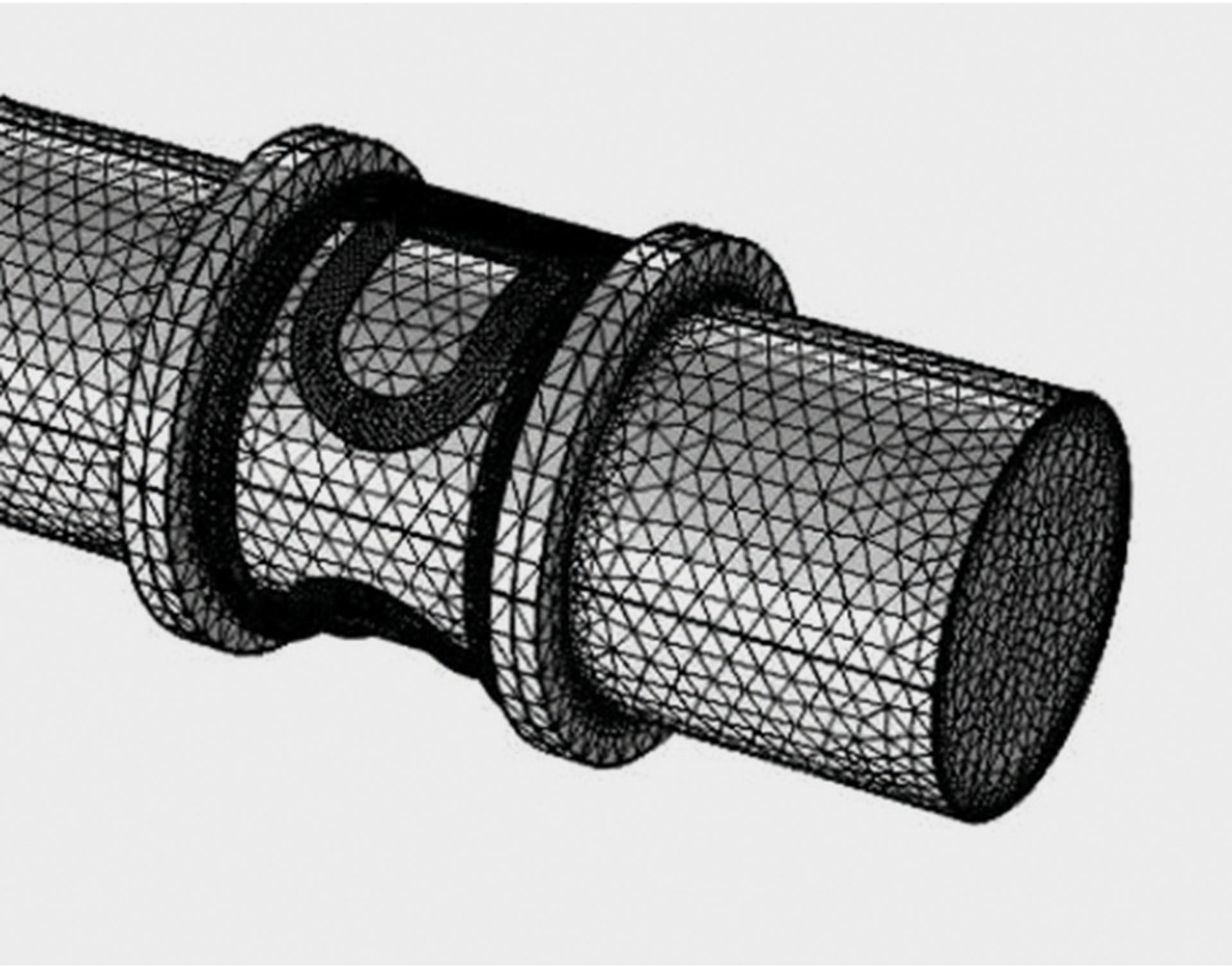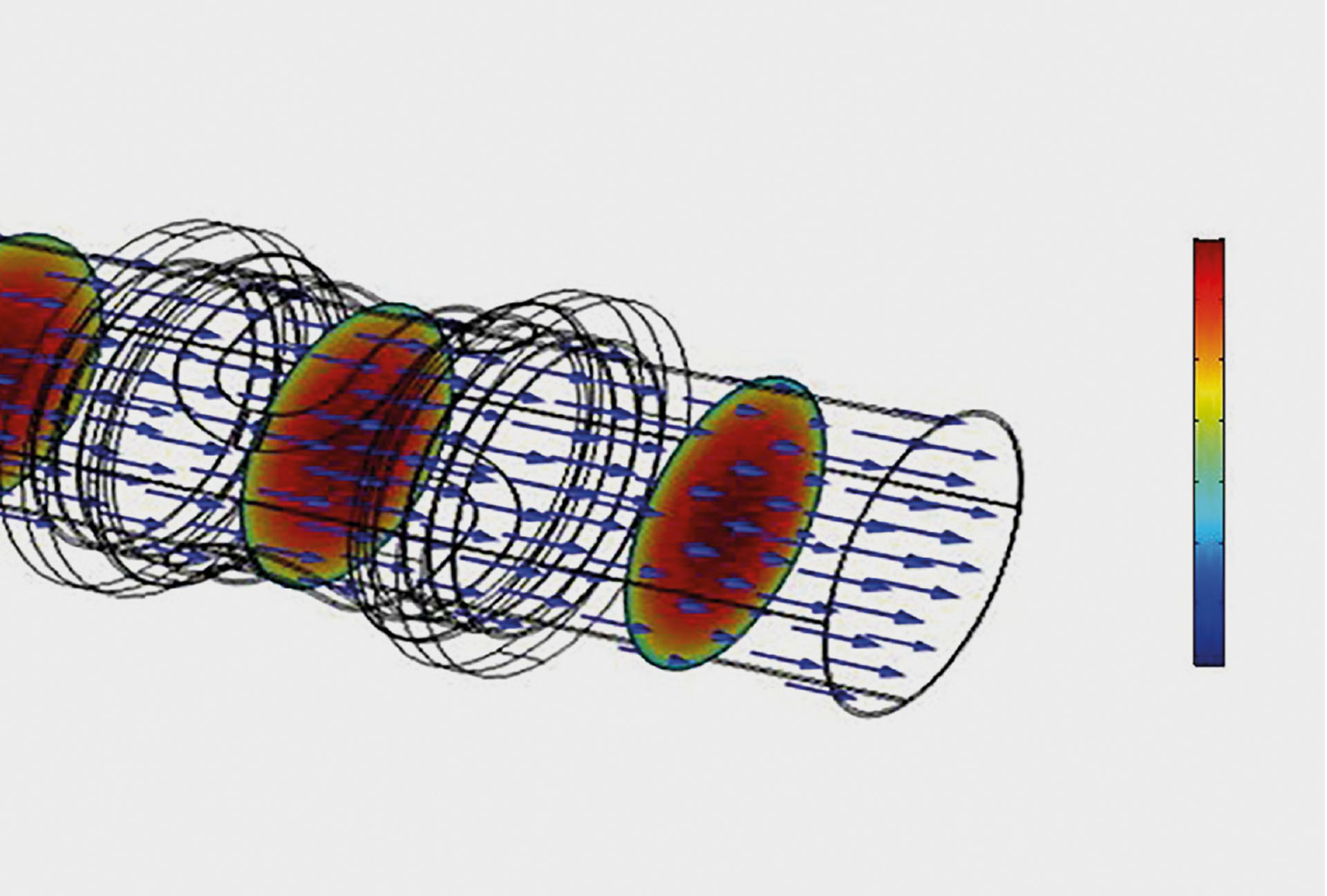Subhashish Dasgupta & Vinay Kariwala of ABB on how they developed a digital twin in order to predict the performance of an electromagnetic flowmeter using simulation tools from Comsol
Flow measurement products from ABB reflect state-of-the-art developments in flow sensing technology.
ABB’s new tool, a digital twin, mimics the actual flowmeter in a virtual environment and predicts electromagnetic (EM) flowmeter performance.
The digital twin based on multiphysics modelling enables flowmeter design improvement and performance prediction under field conditions.
During the last decade, new technologies and digitisation have begun to dramatically impact conventional process industries involving liquids, such as water and wastewater transport and treatment.
As these exciting applications have become more plausible and available, ABB’s dedicated research teams have worked to ensure customers receive the best and most cost-effective tools to improve their competitive edge.
Digital twin technology can do just that by enabling the detection of physical issues early on and predicting outcomes accurately.
Looking to the future, ABB has seized the opportunity to apply digital twin technology to improve its flowmeter products to meet process challenges, deliver value faster than ever before and fulfill ever-increasing customer expectations.
Electromagnetic flowmeters
Production processes require reliable and accurate instrumentation to meet high performance standards.
For more than 40 years, ABB has been a reliable partner to the global water industry, because of its dedication to product development, system solutions and service.
ABB’s flowmeters are traditional workhorses in the production process industry because they are robust, reliable and above all, accurate (see above image).
Comprising a major share in ABB’s flow measurement portfolio, EM flowmeters are especially appealing to customers who transport or process conductive liquids, due to a unique set of advantages: simplicity of installation, negligible impact on pressure drop and high accuracy.
Furthermore, EM flowmeter performance is not susceptible to variations in temperature, pressure or density, nor is it influenced by minor fluctuations in flow profiles.
Independent of flow direction, with measurement errors contained within 0.2 percent over wide flow ranges, EM flowmeters enable accurate measurement at low flow rates.
ABB continually explores tools to improve its electromagnetic flowmeter offerings, with the aim of meeting high performance standards and cost-optimisation demands.
By combining deep knowledge of flowmeter physics with new verifiable modelling techniques, ABB endeavors to add value to existing flowmeters.
EM flowmeters rely on Faraday’s law of electromagnetic induction to determine flow velocity.
When a magnetic field is imposed within a pipe through which a conductive, water like, liquid flows, electric potential or electromotive force (EMF) is induced across the pipe cross section (figure 2).

The EMF is proportional to the flow rate or velocity, and by measuring the induced EMF, flow rate can be estimated.
The ratio of induced EMF to fluid velocity is sensitivity, which is related to the calibration factor. While it is important to predict sensitivity, it is just as critical to predict the variations in sensitivity that result from changing conditions.
Thermal and structural events that can impact flowmeter operation must be evaluated in the interest of product safety and to assess flowmeter performance under harsh conditions.
Digital twin concept
What if one could develop a predictive model based on knowledge of physical processes that would predict flowmeter performance and minimise the need for testing?
The result would be unparalleled productivity and heightened performance.
ABB has developed a software model of an electromagnetic flowmeter based on a multiphysics finite element analysis (FEA) technique to accomplish this.
This software model, or digital twin, is a replica that represents the physical asset in the virtual world, thereby mimicking the physical asset’s real behaviour.
Performance complexities can be understood, problems can be detected and designs can be improved based on the resultant acquired process knowledge.
This information can subsequently be used to build and operate the product in the field.
Digital twins can simulate almost any condition in the virtual world with confidence that the same behaviour would occur in the real world.
Multiphysics model
FEA modelling involves discretising the geometry of an object into smaller finite spaces. The computational model is supplied with information such as material properties as well as operating and boundary conditions.
The model solves physics-based equations over the finite domains to derive parameters. This method, which yields three-dimensional and, if necessary, time-varying information, is employed for performance prediction and design improvement of equipment across industries like oil and gas and aviation.
The use of FEA modelling, as opposed to conventional testing methods, ensures that complex processes can be easily understood.
Laboratory testing methods are limited by their dependence on the number and placement of sensors employed within the equipment, which is cost-intensive and difficult for process industry applications to accomplish.
In contrast, the recent advances and decreasing costs of high-performance computing allows diverse and complex physics based equations to be easily and iteratively solved using FEA.
ABB chose a multiphysics model of an electromagnetic flowmeter to improve its already outstanding flowmeter product offerings.
Integration of physical phenomena
Initially, the geometry of a flowmeter was constructed using a CAD software (figure 3).

The geometry, or the computational domain, was then discretised into minuscule elements across which equations were solved (figure 4).

Several flowmeter samples of varying designs and sizes were modelled (figure 5).

The integration of the two primary phenomena, electromagnetism and fluid dynamics and other diverse physical phenomena within a single model is challenging.
Electromagnetism is analysed by solving Maxwell’s equations. These equations initially calculate the magnetic flux density within the computational domain (figure 6A).
The fluid dynamics are analysed by solving equations of mass and momentum conservation for various flow conditions, simulating fluid flow through the pipe (figure 6B).
Next, the induced EMF, the result of magnetic flux and fluid velocity interaction, is calculated by integrating the magnetic and flow fields, using the Lorentz equations, derived from Faraday’s law of electromagnetic induction (figure 6C).
The primary outcome is sensitivity or the ratio of the induced EMF to the fluid velocity.
To obtain a comprehensive picture, the model also solves for thermal propagation and structural dynamics parameters. Thermal and hydraulic stresses acting on the pipe wall are calculated (figure 7).
Such advanced simulations are essential to predict the effect of challenging, harsh conditions on flowmeter health, like the impact of high-temperature and/or high-pressure liquids passing through the pipe.
The ultimate result of these exhaustive calculations is a complete multiphysics model of the flowmeter that can predict performance as well as impending failure under adverse conditions.
Clearly, modelling has the benefit of minimising the need for testing efforts, which are cost-intensive and time consuming. Several ABB flowmeters, of unique design and varying line sizes, were successfully simulated in 2017.
A comparison of the sensitivities calculated by the model and obtained during field tests revealed an agreement of 95%, establishing the model as a realistic and accurate predictive tool (figure 8).

Besides predicting sensitivity, the model could predict the linearity of the flowmeter or, in other words, the constancy of the sensitivity with changing flow rates — measurement accuracy.
Not only is the digital twin concept an asset during the testing phase, but the model has also been extensively leveraged to modify the existing design of the flowmeter to improve quality.
By incorporating novel component designs and innovative ideas into the model, improvement in flowmeter performance could be evaluated.
The modified flowmeter was found to outperform the existing flowmeter product better than the current flowmeter, setting the stage for future design improvements.
The digital twin, when applied to flowmeter development efforts, will increase flowmeter sensitivity, improve measurement accuracy and reduce manufacturing costs.
Extensive efforts are currently underway to test prototypes of the flowmeter and incorporate the various design modifications and evaluate the feasibility of some of the novel ideas.
Doing less creates more
The primary goal of product development is to minimise material usage while maintaining or maximising the performance level.
Accordingly, the digital twin model has been used to optimise the design of flowmeter components with the intent of reducing material costs.
Being an important component, the EM coil was modified to obtain the optimal size and/or shape for the ultimate flowmeter performance.
Size variation of a given coil was evaluated in a series of iterations (figure 9).

In a particular iteration, the original sensitivity of the flowmeter could be maintained using significantly less copper coil material.
Furthermore, simulations of radically novel coil designs were shown to reduce the amount of material needed to maintain the original performance level.
This is of particular value for the development of large flowmeters because coil costs can make up a substantial portion of total flowmeter material costs.
Recently, proposed solutions to reduce the overall flowmeter footprint for large flowmeters have been evaluated and verified in the subsequent prototype testing phase.
Replicating field conditions
While development and testing are important phases in the product lifecycle, the installation phase has its unique challenges too, given that system features like bends and valves can distort flow profiles and impair measurement accuracy.
Understanding the systemic effect of piping features on flowmeter performance is therefore crucial.
ABB’s electromagnetic flowmeter digital twin was expanded to include a customer piping system (figure 10).

The effect of flow modification on measurement accuracy was studied to provide insight into the impact of system features such as upstream bends.
As a result, ABB could determine the best location to install flowmeters within a given piping system, thereby enabling the correction of flowmeter readings for an installed flowmeter.
To date, the tool has demonstrated veracity in predicting electromagnetic flowmeter performance and enabled engineers to improve the design of flowmeters.
The expansion of the model to simulate the manner in which flowmeter operations influence the flow profiles of customer piping systems also opens up new avenues for the improvement of measurement accuracy.
The digital twin technology can also be employed to serve as a useful guide for flowmeter installation in the field, which enables industries like water management facilities to improve their flow control systems in the interest of radically enhancing industrial process performance.
Extensive research at ABB concentrates on developing the digital twin model for use in other process industries to provide customers with the most advanced digital means of reaching unparalleled productivity and performance.
ABB focuses on maximising value and producing products with fewer defects, ensuring optimal operation, bringing products quickly to market and improving operation.

This article was written by Subhashish Dasgupta of ABB Corporate Research and Vinay Kariwala of ABB BU Measurement & Analytics and was originally published in ABB Review (02/2018)











